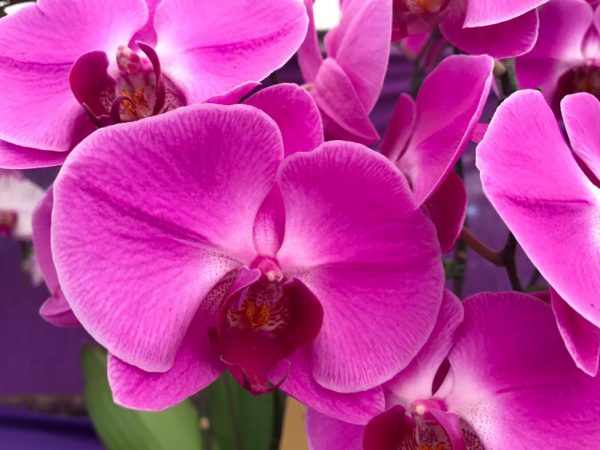Description of pink orchid
The pink orchid is a tropical plant that lives on the roots and trunks of trees. Because in the tropics, the climate is invariably humid and warm, then the same indicators must be maintained at home when growing phalaenopsis.

Description of pink orchid
Description of the variety
Flowers of a pink orchid, similar to mother-of-pearl butterflies, are the main unique feature of this phalaenopsis. On a long Peduncle of dark purple color up to 25-30 cm long, up to fifteen pale pink flowers, connected to sockets, grow. The flowers of the pink epiphyte reach 3 cm in diameter. The color of the central part of the flower, called the anther, is much brighter than the petals.
Phalaenopsis pink orchids are one of the smallest species with oblong, dark green oval-shaped leaves, the length and width of which reaches 15 and 8 cm, respectively. According to the description, the height of the entire plant reaches 45-55 cm.Often the plant has one or two peduncles.
The pink dragon and Viola desiderio are also pink. Viola desiderio is distinguished by large multicolored flowers, 8 cm in diameter. The pink dragon is a hybrid species.
Growing
Phalaenopsis pink is great for growing at home and prefers location on windows with wide east and west sills.
As is the case with many other Orchid species, it is important to take into account that in this family of plants the vital process of photosynthesis is also carried out in the tissues of the roots, therefore they need access to the light resource. This can be achieved by growing the flower in a clear plastic pot.
In the evening, it is equally important to take care of fluorescent lighting. an orchid needs 12 hours of daylight for normal growth and development.
Landing
Often, the vegetative propagation of the pink epiphyte occurs due to the offspring that have grown on the flower itself. After planting the children, flowering should be expected no earlier than a year later.
The soil in the pot must be enriched with drains that have a beneficial effect on growth: pieces of tree bark, coals, finely crushed shells and sphagnum moss.
Care
Temperature and light

Care implies proper watering and temperature conditions.
Care implies the optimal temperature regime for the variety in the winter, which is up to 20 ° C, while in the summer the permissible temperature should not exceed 35 ° C. For pink epiphytes, high air humidity and relatively stable temperature conditions are suitable.
Phalaenopsis are light-loving plants, so a place is suitable for them that will ensure the smooth passage of light, but with an excess of sunlight, the plant must be moved to a more shaded place, because the orchid can burn the flower or leaves, after which it will be difficult to recover.
Watering
Phalaenopsis pink orchids prefer a moderate watering regime.In warm months, plants moisten the soil as it dries once a week, in cold months - only a few times throughout the month. It is important to avoid flooding or, conversely, excessive dryness of the substrate. For irrigation, you need settled water, aged at room temperature. Also, to maintain air humidity, pebbles filled with water must be placed in the pan of the pot.
Top dressing
The procedure for saturating the soil with complex fertilizer is usually carried out once every 2 weeks. An excessive amount of it can inhibit flowering and provoke the appearance of mechanical damage on leaf tissues. An unfavorable concentration of mineral and organic fertilizers provokes inhibition of vital and metabolic processes in the plant, therefore, it is necessary to rinse the substrate under hot water about once a week. The roots of this species are capricious, so they need to be constantly monitored, they should be stably white or light yellow in color.
Diseases and pests
With controlled care, the plant rarely gets sick and almost does not lend itself to damage by dangerous parasites. Still, there are common problems: root decay is not uncommon, and flowers are also prone to lesions from mealy worms, red mites, aphids, spiders, snails, whiteflies, thrips, woodlice, millipedes, etc.
- With the appearance of the scale insect parasite, the leaves of the epiphyte become sticky and covered with dark spots. The pest sucks out the sap from the plant, the composition of which ensures the vital activity of the entire body. The spots appear after the attack of the sooty fungus following the attack of the scabbard.
- The mealybug can cause massive yellowing and leaf fall.
- Whitefly is a small butterfly, white in color. The butterfly itself and its yellow larvae feed on orchid juice, as a result of which the plant noticeably weakens and begins to wilt.
- Thrips also infect leaves, pale pink flowers and roots. Green or yellow larvae actively destroy the inner tissue of the leaves, therefore spots appear on them, and as a result, these organs die off and fall off. Clear traces of the presence of thrips are a silver film and a large number of small black blotches.
Prophylaxis
Preventive measures during care and rearing are as follows:
- maintaining a stable level of temperature and humidity of air and soil;
- periodic inspections of the condition of the plant;
- regulation of the lighting supplied to the plant;
- if necessary - the use of chemicals (with a preliminary study of the instructions);
- transplanting into a new substrate when affected by some types of pests.
Conclusion
The pink orchid is a fragile and incredibly beautiful plant that decorates any room. Feng Shui experts claim that by inhaling the scent of phalaenopsis, a person achieves spiritual harmony and inner peace, so it should be grown in a room in which you relax after a working day. The pink beauty will certainly relax and calm you down.


